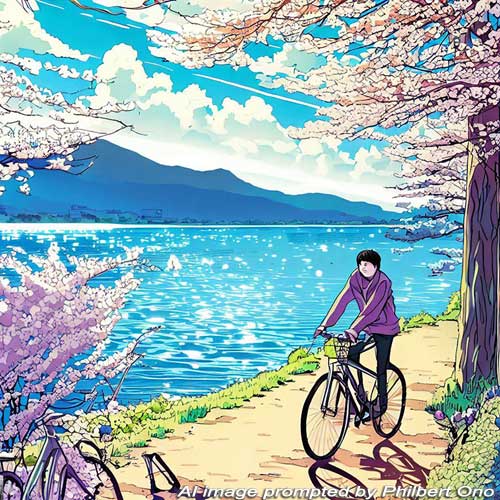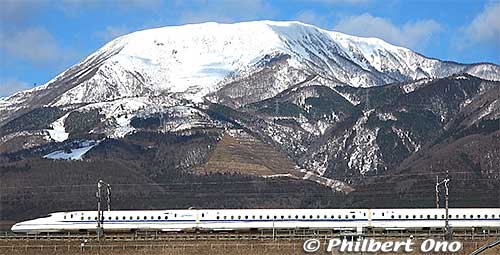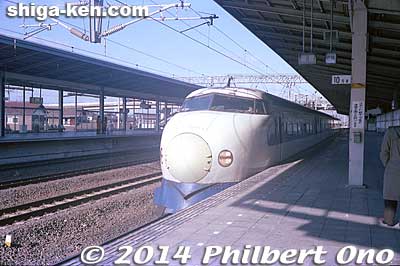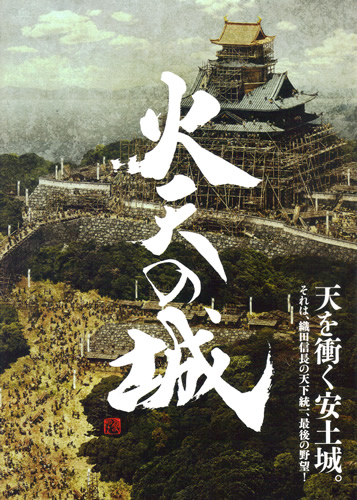
Released in Japan on Sept. 12, 2009, Katen no Shiro (火天の城) or Castle Under Fiery Skies is about Okabe Mataemon, a Nagoya (Atsuta)-based master carpenter who in 1576 was ordered by Japan’s leading warlord Oda Nobunaga to build Azuchi Castle on Mt. Azuchi fronting Lake Biwa.
The main castle tower or donjon was to have an unprecedented five stories. It was to be the grandest and most lavish castle Japan had ever seen. Mataemon and his crew had only three years to complete the epic construction which they did. The movie shows the major and minor tribulations Mataemon and his crew went through during the construction. The movie is also unusual because it has no battle scenes despite being a samurai movie.
Although based on historical facts and persons, the movie is fictional despite having a serious and factual tone. Therefore, to the layman, it is difficult to distinguish between historical fact and the fictional elements.
For one thing, in the movie, Mataemon has a daughter named Rin, whereas he actually had only a son who was groomed to take over his father’s hereditary craft specializing in shrine and temple carpentry. The movie is based on the Matsumoto Seicho Award-winning novel of the same name by Yamamoto Ken’ichi. (I haven’t read the novel.)
Being a castle fan, I really looked forward to this movie. However, I was somewhat disappointed with the quality of the acting, completeness of the story, believability, and overall visual and emotional impact. The movie does have a few outstanding scenes with what looks like thousands of people working, but they were too few and too short. Computer graphics depicting the construction of the mountaintop castle were impressive enough. But I thought there were too many story lines and characters which could not be fully developed or explained within the movie’s 139 min.
It is pretty much an all-star cast headed by Nishida Toshiyuki as Mataemon, Otake Shinobu as his wife, and Ogata Naoto (who gave a fine acting performance) as a woodsman.
Historical Background
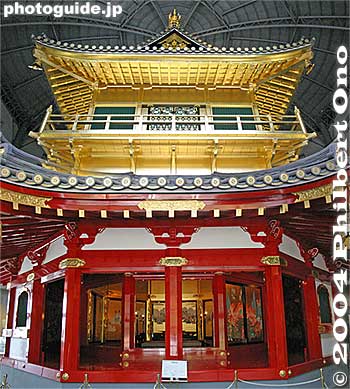
Azuchi Castle (安土城) was one of the grandest and tallest castles Japan had ever seen. Roof tiles with gold leaf and rooms with paintings by renown artists. They say it cost over 100 billion yen based on today’s monetary value, and over 1 million workers were involved. They used 40,000 pieces of wood just for the castle tower alone and the main pillar was made with a 2,000-year-old tree. The castle tower was 35 meters high. Nobunaga lived in the castle tower instead of in a separate palace building. Unfortunately, upon the death of Nobunaga in 1582, the castle was burnt to the ground only three years after it was completed in 1579. Nobunaga was attacked at Honnoji temple in Kyoto where he was staying and forced to commit seppuku by Akechi Mitsuhide, one of his top generals. It is unknown who or what burned down the castle. SInce the castle existed in its full glory for only three years, there are few surviving illustrations showing what the castle looked like. Nobunaga had ordered a painting of his castle on a folding screen. This screen was later given to the Pope by a Japanese mission to the Vatican. Azuchi town officials have been trying in vain to find this elusive folding screen, but even the Vatican is unable to sift through its vast holdings to find it.
Today, the castle tower’s foundation stones and stone walls remain in Azuchi, Shiga Prefecture. It is a pretty easy climb to the top of Mt. Azuchi where you can see the castle tower’s foundation stones. Although Mt. Azuchi was on the shore of Lake Biwa, it is now quite far from the water’s edge due to land reclamation. There is also a splendid, life-size replica of the top floors of the castle tower displayed in a museum in Azuchi called Nobunaga no Yakata. The castle site is near Azuchi Station on the JR Tokaido Line. The Azuchi-Momoyama Period of Japanese history is partially named after this castle.
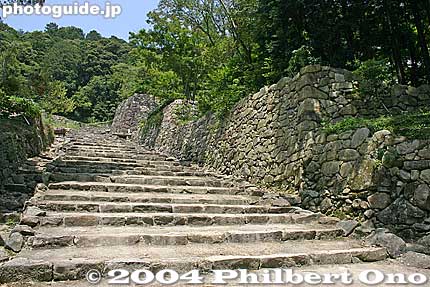
Oda Nobunaga (1534-1582) is one of Japan’s most famous and fabled historical samurai figures. He was the one who put Japan on the road to eventual unification following a period of endless civil wars between daimyo samurai warlords. He rose to power upon the demise of the Kyoto-based Ashikaga shogunate which was losing its national power and authority over the fragmented provinces of Japan. The loss of centralized power resulted in civil wars between rival warlords seeking to expand their territory. One key domain was Kyoto which was the Imperial capital and home of the emperor. Control Kyoto, and you have a good chance of controlling the entire country.
After winning a number of key battles, Nobunaga came to control Kyoto and became one of the most powerful daimyo with about one-third of Japan under his control. One key to his success in battle was the introduction of firearms. Matchlock guns came to Japan from Europe with which Japan had trade relations. Nobunaga developed an efficient way to use guns in battle which were no match for the swords of his enemy. After the decisive Battle of Nagashino in 1575 when Nobunaga defeated the Takeda clan, he wanted to show off his power and authority by building the grandest castle ever at Azuchi. He thought Azuchi was the hub of Japan’s major domains including Kyoto.
Nobunaga also favored European culture. In the movie, you can see a few things from Europe such as a globe that showed that the world was round. (Although Nobunaga believed the Europeans, the Japanese still thought the world was flat.)
Nobunaga was bent on conquering all of Japan and would likely have succeeded if he weren’t assassinated. Nobunaga was succeeded by Toyotomi Hideyoshi who did succeed in unifying Japan. However, his death led Edo-based Tokugawa Ieyasu to seize the opportunity to take over the country. After a pivotal battle at Sekigahara in Gifu Prefecture, he and his descendants maintained peace in a unified Japan for over 250 years from 1600.
Okabe Mataemon (岡部又右衛門) was a master carpenter specializing in building shrines and temples. He was the head carpenter for Atsuta Shrine in Nagoya. Atsuta is one of the three most important shrines in Japan (besides Ise in Mie and Izumo in Shimane). Nagoya is in Aichi Prefecture which was known as Owari Province. Nobunaga also hailed from Owari so he already knew about Mataemon. Mataemon’s carpentry skills were considered so legendary that he was called the man with “Kami no te” (God’s Hand or Divine Hand). He was a great influence on succeeding generations of shrine/temple carpenters which was a hereditary occupation. To become a master shrine/temple carpenter, you had to be born into it. Mataemon had 20 carpenters working under him. He is presumed to have been with Nobunaga during the attack at the Kyoto temple and thus presumed to have died with Nobunaga.
Movie Plot
*Note that since this movie is not a suspense or mystery, it should not spoil your enjoyment of the movie by reading this plot.
The movie opens with Mataemon’s daughter Rin hugging or listening to a large tree when she sees a small group of samurai on horseback speeding toward Mataemon and his crew who were building a shrine. It turned out to be Nobunaga himself who first requested a drink of water. He then reveals the real purpose of his sudden visit. That he wanted Mataemon to build an unheard-of, five-story castle on a mountain in Azuchi. Mataemon accepts the challenge with great honor.
However, Nobunaga later makes it a castle design competition between three famous carpenter clans including Mataemon. The other two competitors were the Kyoto-based Ikegami who designed the Gold Pavilion (Kinkakuji) in Kyoto and the Nara-based Nakai who built Todaiji temple’s Great Buddha Hall in Nara.
In front of Nobunaga, the three bidders formally presented their impressive designs one by one with drawings and a scale model. Nobunaga had instructed the designers to include an atrium inside the castle tower. The center of the building would be an empty space up to the upper floors. Nobunaga apparently wanted to imitate the interior of a cathedral with a high ceiling. The Ikegami and Nakai complied and showed the high open space inside the castle tower in their designs.
Lastly, Mataemon presented his design as a seven-story structure including two basement floors. However, he did not incorporate an atrium in what seemed to be a defiant act. This enraged Nobunaga so much that he drew his sword. However, Mataemon tearfully explained and dramatically demonstrated (one of the movie’s best scenes) his reasons. That having an atrium in the castle would make it a firetrap. That a carpenter’s job is to protect the life of the master (Nobunaga) and that he could not build something that would be hazardous to his lord’s life in case the castle fell. Nobunaga acquiesced and declared Mataemon as the Head Carpenter (So-toryo) for building the castle. (This scene was impressive, however, there was no explanation of the tower’s unique octagonal top floor.)
The castle construction started in Jan. 1576. Tens of thousands of craftsmen and workers were mobilized from 66 provinces to construct the castle in three years. The entire mountain was to be converted into a fortress and grand residence for Nobunaga. Computer graphics created the scenes of the castle being built on the mountaintop. The story then turned to Mataemon in search of a giant cypress (hinoki) which can serve as the castle tower’s main pillar. He explains to Nobunaga that for a tree that big, it would have to be 2,000 years old, and such a tree might only be found in the Kiso mountains (in Nagano Prefecture).
However, the Kiso area was in enemy territory under the Takeda clan. Even though it might be suicidal to go there searching for a tree, Nobunaga allows Mataemon to travel to Kiso while carrying a letter of introduction from him. Mataemon is soon caught by local lord Kiso Yoshiaki. At knifepoint, he tearfully begs for permission to search the mountains for the tree. He even offers his life in exchange for the tree. Lord Kiso reluctantly allows him to search for the tree, without actually intending to let him get the tree.
Mataemon is accompanied by a local woodsman named Jinbe. They spend days searching for the perfect tree. After hearing Mataemon’s motivation and sense of mission, Jinbe warms up to Mataemon saying that he would love to see such a tree rendering great service to the land’s greatest castle. Just when Jinbe had all but given up in finding such a tree, Mataemon wanders around by himself and miraculously finds it. He hugs the tree, and while Lord Kiso’s spies watch them, Jinbe starts hitting Mataemon to mislead them. While giving a good beating, Jinbe promises Mataemon that he would get him the tree when it rains heavily. With this, Mataemon returns to Azuchi with a firm belief in Jinbe’s promise to deliver. (Part of this scene in the forest was filmed in Taiwan. Apparently Japan does not have any trees that look that big.)
Meanwhile, there were military orders to send five of Mataemon’s carpenters to the battlefront. Young Ichizo volunteered to go. He was a love interest of Mataemon’s daughter Rin who tearfully sees him off to war. Later when the army returned, Rin searches for Ichizo, but does not find him among the returnees. One of the returning men broke down and cried when she asked him about Ichizo. We can only presume that he was killed in battle.
Time passed by, and with no heavy rains, the giant tree still did not arrive. This made everyone very anxious. Mataemon’s wife Tazuru went to pray at various shrines when finally pouring rain falls. In the heavy rain, Mataemon falls to his knees on the main pillar’s foundation stone and prays in gratitude. Apparently, a lot of rain was needed to haul the big tree down the mountain river. Later, while praying at a shrine on a sunny day, Mataemon’s wife finally sees a welcome sight on the lake.
The giant tree on rafts on Lake Biwa was heading toward Azuchi with Hashiba (Toyotomi) Hideyoshi on board. Everyone is greatly relieved and happy. However, by delivering the tree, Jinbe defied Lord Kiso’s order not to give the tree. Jinbe is beheaded. A letter from Jinbe to Mataemon implied that Jinbe gave his life to fulfill Mataemon’s dream. Mataemon cries for Jinbe in what might be the movie’s most touching moment.
With great ceremony and hundreds of men pulling ropes, they erect the castle’s main pillar cut from the giant tree from the Kiso mountains. The pillar is erected on the central foundation stone. It is one of the most dramatic scenes of the movie, showing various contraptions to pull the giant pillar from a horizontal to vertical position. Meanwhile, Mataemon’s wife falls ill and dies. Mataemon rushes home and mourns her for a night before he goes back to work.
A few of Nobunaga’s men notice a huge and nice looking boulder in the mountain and decide that it would befit Nobunaga’s castle. They order it to be removed and used for the castle. However, the stonecutter opposes, saying that it was a sacred rock and removing it would result in a curse. The samurai disagreed and was ready to behead the stonecutter who was a close friend of Mataemon. Mataemon intervenes and the stonecutter reluctantly gives in to the demand.
The next epic scene shows the hauling of the giant boulder up the hill on a path of rolling logs. Good mix of computer graphics and real men hauling the rock. However, as they were pulling, there was a gunpowder explosion on the path as a distraction and several ninja-like assassins (called rappa) disguised as workers went after Nobunaga who was standing on a very high platform to watch the hauling of the boulder. One female assassin disguised as a kitchen worker, named Une, leaped (actually flew) up to Nobunaga’s grandstand and engaged him in a sword fight. She was thrown to the ground where she was stabbed by Nobunaga’s men. Une had appeared in the movie a few times before, working as a kitchen helper. She was the love interest of Kumazo, one of the construction workers who wanted to marry her (but she laughed off his proposal). He saw Une being attacked and tried to protect her, but he was killed as well.
The scene with Une flying up to Nobunaga and fighting him was like a Chinese kung fu movie, complete with sound effects (of clothes ruffling in the wind). I thought, “Whaaa?? What is that??” Until then, it was a serious movie, and it suddenly turned into a Nintendo-like sequence. Quite out of place. The story behind Une is not explained either. She just came out of the blue and was killed off. We don’t know who she was working for.
Meanwhile, the giant boulder broke loose and went tumbling down the hill squashing many people in its path. (I bet this accident is fictional.) Everyone is greatly saddened by the death of Kumazo and many others. Mataemon orders a break in the construction so everyone can mourn. However, Nobunaga orders Mataemon to resume the construction immediately even though Mataemon pleads that it wouldn’t work if the workers’ hearts were not in it.
Later, during heavy rains at night, Mataemon was inside the castle tower and noticed water dripping from above. He climbs up on a ladder and walks on a few wooden beams to try and find out what was wrong. He tries to “listen to the wood.” He concludes that the foundation stones under the pillars surrounding the main pillar had sunk slightly. This made the main pillar, at the center, slightly too tall for the beams connected to it. This height difference would eventually cause the connected beams to break or the main pillar to crack. So he decides that the main pillar had to be shaved off at the bottom by 12 centimeters. His crew is aghast, exclaiming that it was impossible.
Then suddenly, a haggard-looking Ichizo, who was presumed to have died in battle, enters the building shouting, “It’s not impossible, he has God’s Hand!” (Ichizo idolized Mataemon.) An elaborate system to lift the pillars and beams was constructed and we see men, women (including Rin), and even children pulling the ropes to raise the pillars by some centimeters. They hung on to the ropes lifting the pillars as their hands bled. A carpenter sawed off the bottom of the main pillar and Mataemon and Ichizo shaved it some more until Mataemon gave the okay signal. All the pillars and beams then creaked back into the correct position. It’s hard to tell what the timeline is in the movie, but apparently the job took overnight.
In the end we see Nobunaga in the castle praising the castle and saying a few words to his retainer.
My Impressions
Here is a summary of what I liked and didn’t like about the movie:
What I liked:
- Grand scenes such as when they are raising the castle’s main pillar and pulling a giant boulder. That pillar, BTW, was an actual hinoki pillar they bought for 8 million yen.
- Computer graphics showing the building of Azuchi Castle.
- Ogata Naoto’s acting performance as Jinbe the woodsman. (He’s become quite a good actor like his father.)
What I didn’t like:
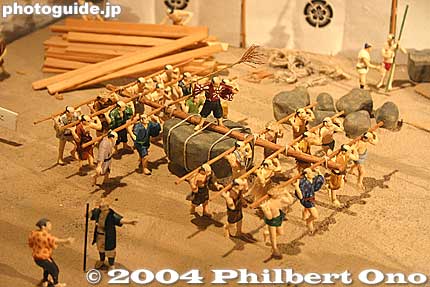
- Although Okabe Mataemon and Azuchi Castle actually existed, the movie’s story is still fiction. Mataemon had a son instead of a daughter as depicted in the movie. And so it is difficult to distinguish fact from fiction in the movie.
- Except for Ogata Naoto (and maybe Shiina Kippei who played Nobunaga), the quality of the acting in general was not very high. It seemed more like a made-for-TV drama than a movie.
- A few story lines and characters were not adequately developed or explained such as the love interest of Rin and Kumazo, and the ninja-like sabotage by Une.
- The movie’s passage of time is difficult to distinguish. Like how many days or weeks passed until the big log arrived from Kiso?
- There were too few epic scenes like when they were erecting the main pillar and pulling the giant boulder. And those scenes were too short as well.
- The scene where they were pulling a giant boulder ended too abruptly when ninja-like saboteurs appeared and tried to kill Nobunaga who was watching the spectacle. One of the female ninja (Une, played by Mizuno Miki) jumped (flew) up to the high platform where Nobunaga was standing and engaged in a sword fight. It was like a Chinese kung fu movie. She was superhuman to be able to jump up that high. Nintendo-like scene in a serious movie. (They put wires on her and she flew up 10 meters. The actress commented that it was more thrilling than an amusement park ride.)
- There was no element of suspense or mystery or story line leading up to a final conclusion. The movie really didn’t have a climax.
- No scenes showing other aspects of the castle’s construction such as the stone walls and especially the gorgeous Kano-style paintings and gold leaf inside the castle rooms.
- No scene showing Nobunaga praising Mataemon for his great job.
- No scenes showing Nobunaga actually living inside the castle.
- No scenes of the Christian missionaries and other dignitaries who saw the castle and marveled at its beauty. This could have been the movie’s climax.
- No scene related to the legendary folding screen with a painting of Azuchi Castle ordered by Nobunaga. The folding screen was later given to the Pope and the town of Azuchi has been searching for it since there is little documentation of the castle’s appearance.
- No scenes of the castle burning three years after it was completed. It is only mentioned in the end narration.
- The movie does not mention the word “Shiga” or “Omi.” The movie does not promote any places (other than Azuchi), people, or products of Shiga. We only see chado instruments (tea cups, etc.), Western things like a globe (shown by Nobunaga) and fancy dress by women (from Sakai, Osaka).
- None of the main actors/actresses are from Shiga Prefecture.
- Shiga Governor Kada Yukiko did not make a cameo appearance. I heard that actor Nishida Toshiyuki asked her to make an appearance, and I thought she agreed. But you don’t see her in the movie.
I know the movie is based on the Naoki Prize-winning novel which probably did not include the scenes I described above. But to make it more dramatic and entertaining, I think the screenwriters should have included such scenes. As I listed above, there are just too many scenes missing in this movie. Perhaps they didn’t have enough time to fit it all in. They should have cut out the romances between Rin-Ichizo and Une-Kumazo. I thought it was a waste of time. The movie is not a love story. If it supposed to be a love story, it failed completely.
Even for history buffs, it might be frustrating because the movie is obviously not historically accurate since it is a work of fiction. For castle fans, the movie does not show all the major aspects of building a castle. I wish they showed more scenes of the actual construction (which sped by too quickly).
Work on the stone walls, interior, moats, etc., are missing. Seeing the stones being cut and fitted onto the walls, the beams being fitted to the main pillar, the construction of the roof, moat digging, interior painting, gold leafing, etc., etc. So the educational value of this movie is not very high.
The movie does have many interesting story lines. Construction of a major castle with mostly manual labor, Mataemon the carpenter prodigy, Nobunaga’s affection for imported goods, merchants getting rich from European trade, ninja-like assassins, and a few love stories. But the movie was too short to adequately cover them all. It tries to cover everything, but in doing so, it never really developed any story to its fullest and best potential. It might have been better to make it a TV series rather than a movie.
I was also disappointed that Shiga Governor Kada Yukiko did not make a cameo appearance. I had heard that leading actor Nishida Toshiyuki asked her to appear in the movie. I thought she agreed. Well, you won’t see her in the movie. The movie also does not mention the word “Omi” or “Shiga.” And it does not introduce any places, people, or products from Shiga. Also, none of the main actors/actresses are from Shiga.
But I still recommend seeing this movie. It is worth seeing the few outstanding scenes that it has. The movie was filmed in Kyoto; Adogawa in Takashima, Shiga where they filmed the giant boulder scene with 200 extras; Awajishima island in Hyogo for scenes atop Mt. Azuchi overlooking Lake Biwa; Kiso-Fukushima in Nagano for forest scenes; and Taiwan for the big tree scene.
Cast
You could call it an all-star cast with big names such as Nishida Toshiyuki, Otake Shinobu, Shiina Kippei, and Ogata Naoto. *All names have the family name first.
- Nishida Toshiyuki – Okabe Mataemon the head carpenter.
- Shiina Kippei – Warlord Oda Nobunaga.
- Ôtake Shinobu – Mataemon’s wife Tazuru.
- Ogata Naoto – Jinbe the woodsman
- Natsuyagi Isao – Stonecutter.
- Terajima Susumu – Senior carpenter 平次
- Fukuda Saki – Mataemon’s daughter Rin.
- Ishida Takuya – Ichizo, carpenter who idolizes Mataemon. Love interest of Rin.
- Yamamoto Tarô – Kumazo, somewhat rebellious carpenter who liked Une.
- Ueda Kôichi – Senior carpenter and father of Ichizo. 弥吉
- Mizuno Miki – Une, the female assassin disguised as kitchen worker and the love interest of Kumazo.
- Nishioka Tokuma – Nobunaga retainer and castle construction supervisor
- Sasano Takashi – Lord Kiso Yoshiaki, local lord under the Takeda clan.
- Kômoto Jun’ichi – Hashiba (Toyotomi) Hideyoshi.
- Maeda Ken – Carpenter.
- Pe Jyonmyon – Carpenter.
- Watanabe Ikkei – Nobunaga retainer.
- Taguchi Hiromasa – Nobunaga retainer.
- Kumagaya Mami – Kitchen worker Fusa.
- Ishibashi Renji – Famous carpenter Ikegami of Kyoto who bid for the Azuchi Castle design.
- Uchida Asahi – Famous carpenter Nakai from Nara who bid for the Azuchi Castle design.
- Endô Shôzô – Merchant from Sakai, Osaka who got rich from European trade and paraded with young women in fancy western dress.
- Director: Tanaka Mitsutoshi
- Producer: Fujita Shigeki
In Shiga, the movie is playing at the following theaters (phone number in parentheses):
Otsu: United Cinemas Otsu (077-527-6188) and Otsu Alex Cinemas (077-527-9616)
Hikone: Hikone Viva City Cinemas (0749-26-1002)
Omi-Hachiman: Warner MyCal Omi-Hachiman (0748-37-3433)
Kusatsu: Warner MyCal Kusatsu (077-561-4545)
Koka: Minakuchi Alex Cinemas (0748-63-8801)
Official Web site (in Japanese only): http://katen.jp/ (Website discontinued)
Key Words
If you are studying Japanese, this list of words may be helpful to know before watching the movie.
- Katen no Shiro 火天の城 – Movie title. “Katen” is not a normal Japanese word. It is the name of one of the twelve Deva guardians (Juniten 十二天) guarding twelve directions in esoteric Buddhism. The twelve deities protect the world. Katen is the God of Fire in the southeast. This god burns one’s ignorance and illuminates the darkness to show a confused person the correct path. Other Deva guardians include Bishamonten, Taishakuten, and Suiten.” Shiro” means castle.
- Azuchi 安土 – Name of the place and mountain where Azuchi Castle was built in Shiga Prefecture. Azuchi is next to the city of Omi-Hachiman and the castle site is nearest to JR Azuchi Station on the Tokaido Line. The Azuchi-Momoyama Period of Japanese history partially refers to Nobunaga’s Azuchi Castle. (“Momoyama” refers to Toyotomi HIdeyoshi’s castle in Fushimi, Kyoto.)
- miya-daiku 宮大工 – Carpenter specializing in shrine/temple construction. Okabe Mataemon was one of Japan’s most famous miya-daiku.
- touryou or So-touryou 棟梁/総棟梁 – Master carpenter or head carpenter like a foreman at the construction site. It is also an honorary title used to called the master carpenter, similar to the use of “sensei” for a teacher. Mataemon is addressed as “Touryou” by his underlings.
- Goju no tenshu or Goju no shiro 五重の天守 – Five-story castle tower. “Goju” might sound like the number 50, but it means five stories. Later you will hear “nanaju,” which means seven stories since there were two basement floors.
- Tenshu 天守 – Castle’s central tower or donjon.
- sashizu 指図 – Design blueprint for a building. Called sekkei-zu 設計図 in modern language.
- sakuji 作事 – Construction work.
- oyabashira 親柱 – Main pillar of a building.
- hinoki 檜 – Japanese cypress, famous for its fragrance and beauty. This is the type of tree used for the castle’s main pillar.
- kami no te 神の手 – God’s hand or divine hand. Refers to Mataemon’s top-class carpentry skills.
- fukinuke 吹き抜け – Atrium.
